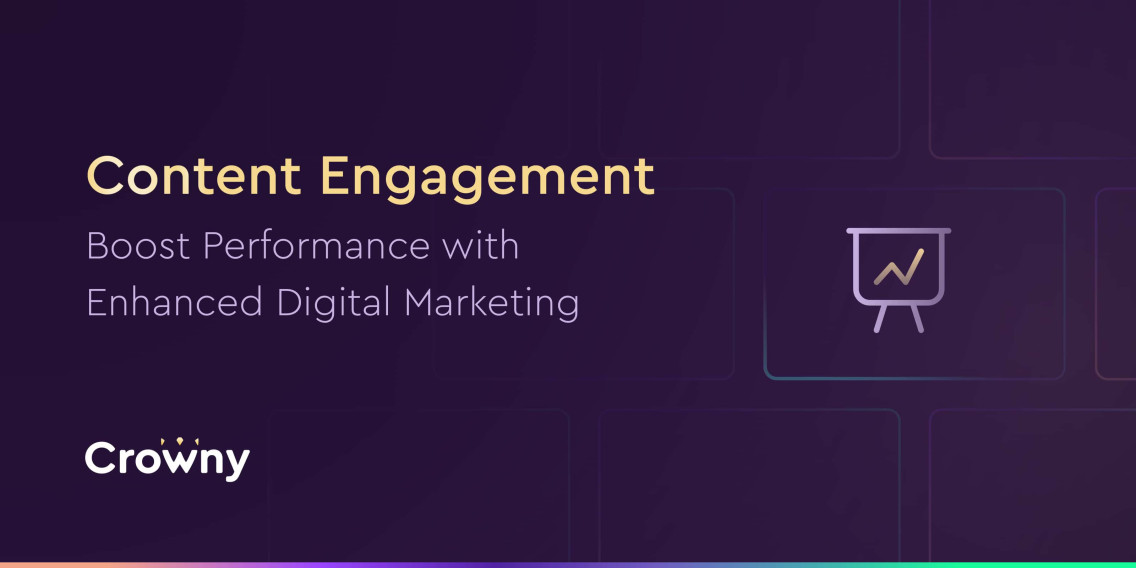Discover effective content engagement strategies to maximize interactions and captivate your audience. Let's dive in and discuss the means for online success!
Table of contents
What is content engagement?
Content engagement refers to the level of interaction, involvement, and connection that users have with your online content. It encompasses actions such as likes, comments, shares, time spent on page, and conversions.
.jpg)
Why is content engagement important?
When it comes to online marketing, content engagement is a key metric that can directly impact the success of your strategy. Numerous studies have shown a strong correlation between high levels of content engagement and positive business outcomes. Engaging content not only attracts more visitors but also keeps them coming back for more. Here are some statistics that back our statements:
☑️82% of marketers are actively investing in content marketing (HubSpot, 2021)
☑️Between 2021 and 2022, there is a 52% increase in the number of content creators (Parse.ly, 2022)
☑️54% of organizations spent up to 50% of their marketing budget on content marketing (Semrush, 2022)
☑️Content marketing is more likely than other digital marketing areas to be allocated 100% of the budget (SEJ, 2022)
☑️79% of organizations have 1 to 10 people creating content (Parse.ly, 2022)
☑️91% of marketing pros surveyed by Semrush achieved success with their content marketing in 2021 (SEJ, 2022)
It increases engagement
Sounds logical, but engagement goes beyond mere views or clicks and focuses on how well your audience engages with and responds to your content. Content engagement fosters a two-way conversation between you and your audience. When users actively engage with your content, they become more invested in your brand. This engagement builds a sense of trust, loyalty, and emotional connection, which can lead to increased brand advocacy and customer retention.
Creates community
Engaging content has the power to bring like-minded individuals together and foster a sense of community, also referred to as community marketing. By facilitating discussions, encouraging user-generated content, and providing platforms for interaction, you can cultivate a loyal community around your brand. This community can become a powerful force in spreading your message and driving organic growth.
Builds fruitful relationships
When users engage with your content, they are signalling their interest and intent. This opens up an opportunity for you to nurture these relationships further and convert engaged users into customers or brand advocates. Engaging content allows you to establish a connection with your audience, understand their needs, and tailor your offerings accordingly.
.jpg)
How to measure content engagement?
Measuring content engagement requires a combination of qualitative and quantitative analysis. Quantitative metrics include views, likes, shares, comments, time on page, and conversion rates. These metrics provide an overview of the engagement level. Qualitative analysis involves studying the sentiment, quality of comments, and depth of interactions to gain deeper insights into audience preferences and behavior.
More than half of content marketers use email engagement, social media engagement, website engagement, and conversions as metrics (Parse.ly, 2022)
What are content engagement strategy KPIs?
Key Performance Indicators (KPIs) for content engagement vary based on your goals and the nature of your business. Some common KPIs include social media engagement (likes, comments, shares), email open and click-through rates, time on page, bounce rates, and conversion rates. Set specific goals and track these metrics regularly to assess the effectiveness of your content engagement strategies.
Best practices to maximize content engagement
Content market fit
To maximize content engagement, it's crucial to understand your target audience and create content that resonates with their needs, interests, and pain points. Conduct thorough research, create buyer personas, and tailor your content to address their specific challenges. When your content provides value and relevance, engagement naturally follows.
Content optimization
Optimizing your content for search engines is essential to increase visibility and attract organic traffic. Conduct keyword research to identify relevant search terms and incorporate them naturally into your content. Use captivating headlines, compelling introductions, and visually appealing media to capture and retain your audience's attention. Additionally, make your content scannable by using subheadings, bullet points, and short paragraphs.
Funnel-driven approach
Crafting content that aligns with each stage of the customer journey is vital for maximizing engagement. Create awareness through educational and informative content, nurture leads with personalized and value-driven materials, and convert prospects with compelling calls-to-action and persuasive content. Mapping your content to the different stages of the sales funnel ensures that you engage users at each step of their buying process - ensuring you utilize your content to benefit the entire lifecycle and boost customer lifetime values.
Omnichannel strategy
Engagement opportunities exist across various digital channels, such as social media, email, blogs, and video platforms. Develop an omnichannel strategy to reach your audience where they spend their time. Tailor your content for each platform, maintain a consistent brand voice, and encourage cross-channel interactions. By diversifying your content distribution, you increase the likelihood of engagement and reach a wider audience.
.jpg)
What the industry is missing
Problem: fragmentation between engagement and loyalty
Over the past years, the fragmentation between content engagement and customer loyalty has become more prominent. Some brands may have followers, but no engagement. Other brands may have engagement, but the engagement does not translate to revenue. Demand for a cohesive approach that integrates content engagement and customer loyalty seamlessly increases. Traditional marketing strategies often include email marketing to drive loyalty, while loyalty programs focus on rewards and incentives for engaged customers. This approach works fine but is definitely not tailored to serve the described purpose - a lot of upside is left untapped. It has prevented many brands from increasing user engagement, and thus realizing their full potential.
The number one marketing challenge is attracting quality leads with content (Semrush, 2022)
Cause: online brand communities are barely encouraged
People who engage with a brand, whether online or offline, often go unrecognized and are not captured in an environment that nurtures and builds a strong relationship with them. Successful brands like Nike have found a solution with app marketing. Capturing their audience in a mobile app allows them to distribute targeted, high-performance content while rewarding customer loyalty. It ensures they get more people actively engaged with the brand, and it gets them more people in their loyalty loop. By applying the best practices we mentioned earlier, Nike makes sure to gradually improve their mobile app engagement over time. However, not every brand has the same resources and influence as Nike, leaving loyalty marketers searching for alternatives.
Solution: Crowny
Crowny offers a groundbreaking solution that enables brands of any size to match and exceed the relationship marketing experiences offered by major brands. With Crowny’s Web3 Loyalty Platform, brands can create their own in-app experience and host branded loyalty and content profiles. Leveraging blockchain technology, Crowny provides a branded token economy that incentivizes subscribers to engage with exclusive and personalized content through push notifications and QR codes.
-1689773068.jpg)
Lowering the barrier for any brand
We lower the barrier for any brand to kickstart its own app marketing. Instead of having to build a mobile app from scratch, brands of any size can now take advantage of a pre-built and optimized app: the Crowny App. But anyone can start, that's not where success is accomplished. A well-known problem of brands with app is that they fail to get a positive ROI on their upfront investment. It's because, with a dedicated app for each brand, every brand strives to attract its unique user base. Consumers will only download so many apps on their phones. By representing your brand in a multi-brand ecosystem, brands bundle their pulling power. When discussing the upfront investment, the process of developing loyalty and mobile marketing software immediately comes to mind. Without getting into too much detail: the upfront costs of software development are one of the most common reasons why businesses drop out. Instead, utilize already developed and tested ‘plug and play’ software: the Crowny App.
But wait, there's more:
Blockchain-based loyalty rewards offer many benefits as well, like automated administration possibilities. It also allows users to earn points for engaging with content and performing valuable actions, following the unique interact-to-earn mechanism. A win for both the business and its community members. These points can be spent on loyalty deals available in the in-app loyalty store, tailored to their preferences.
Learn more about mobile-first blockchain loyalty programs. It is a well-researched concept and seems to solve everything that traditional loyalty programs lack. Add Crowny’s user-friendly app features and mobile app features for loyalty specifically, and great performance becomes a realistic objective.
How to start
In conclusion, content engagement plays a pivotal role in any successful online marketing strategy. By understanding the importance of content engagement, measuring it effectively, and implementing best practices, brands can drive customer loyalty, foster communities, and build meaningful relationships with their audience. Brands of all sizes now have the opportunity to create compelling content experiences and harness the power of engagement for sustainable growth.
Get early access to a demo now.

